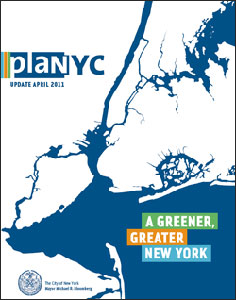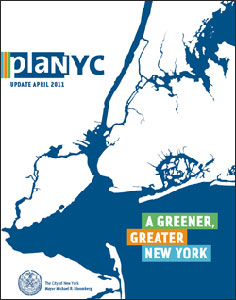by: admin
Event: PlaNYC Update 2011 Workshop: Growth Issues — Assumptions and Implications
Location: Center for Architecture, 07.29.11
Speakers: Katie Theis, AICP, LEED AP — Senior Planner, HNTB Corporation, & Chair, Urban Design Committee, New York Metro Chapter, American Planning Association; Stephen Whitehouse, RLA, AICP — Partner, Starr Whitehouse; Margaret Castillo, AIA, LEED AP — Principal, Helpern Architects & 2011 AIANY President
Moderator: Ernest W. Hutton, Jr., Assoc. AIA, FAICP — Principal, Hutton Associates/Planning Interaction, & Co-chair, New York New Visions
Organizers: New York New Visions; AIANY Planning and Urban Design Committee; APA NY Metro Chapter; ASLA NY Chapter; Citizens Housing & Planning Council
Three months after the unveiling of PlaNYC version 2.0, with its emphasis on achievable and affordable incremental improvements, members of professional and civic organizations discussed ways to sustain the plan’s momentum in an era when public sector funding is dropping and political contexts are shifting. The next few years will present demanding tests of “how much of PlaNYC can be incorporated into our DNA, and it becomes, if we all believe in it, part of NYC, [not] just a political thing that can be undone with the next mayor,” said 2011 AIANY President Margaret Castillo, AIA, LEED AP. Translating a planning document into an effective management toolkit, panelists claimed, can make the difference between a vision of a sustainable city — compelling but provisional — and a permanent reality of one.
Moderator Ernest Hutton, Assoc. AIA, FAICP, sorted strategies for managing population growth and appropriate development into three categories: creating housing capacity for a diverse demographic mix; expanding, revising, and operating the city’s parks so that they are both a public amenity and a functional component of the city’s infrastructure; and encouraging brownfield and waterfront development in ways that mesh with community needs, transit systems, and ecological imperatives. Specific goals within these policy areas frequently collide at the local level. American Planning Association (APA) representative Katie Theis, AICP, LEED AP, raised critical questions of policy integration and priorities. Everyone, she claimed, agrees the city needs more affordable housing, for example, and rapid remediation of the city’s 7,000 acres of brownfields is a major PlaNYC goal, but do these aims add up to a need for dense residential development on waterfront brownfield sites over a mile from the nearest subway stop?
As the waterfront, once dedicated to industry and shipping, attracts more recreational functions and offers the potential to expand the transportation system, the relative roles of large developers and smaller ones may need rethinking. John West, AIA, and other audience members raised important questions about infill development and bottom-up community involvement: perhaps a period of minimal public expenditure calls for more incentives directed toward small-scale, as-of-right construction in under-the-radar locations, rather than high-profile developments requiring concentrated investment.
Stephen Whitehouse, RLA, AICP, who served at the Parks Department for 13 years, described many of the nuts, bolts, silos, roadblocks, and incentives associated with city agencies. Rational policy coordination and resource allocation have long been “the bureaucrat’s dream,” he noted, and some of PlaNYC’s measures actually build on efforts initiated decades ago, like the original Greenstreets (a comprehensive traffic-calming strategy, before it morphed into a planting program). Yet control of budgetary streams by different offices (the mayor, borough presidents, and city council) militates against effective pursuit of sustainability objectives, which are always complex and interdisciplinary. Stormwater, he noted, pays no heed to jurisdictional boundaries: “it falls where it will, and it flows downhill.”
It behooves supporters of PlaNYC, the panelists agreed, to clarify its various benefits for public consumption. Theis hailed the marshaling of traffic-safety statistics by the Department of Transportation, Transportation Alternatives, and others in defense of Complete Streets projects, calling for similar evidence of its effects on local business. Castillo inquired whether the professional societies’ participation in elections, League of Conservation Voters-style, vetting candidates and engaging in voter education (though probably pulling up short of endorsements), might usefully raise the level of debate. Workshops like this one, Hutton suggested, could yield documents clarifying AIA/APA/ASLA positions and give the public better information about the long-range value of upgrading and maintaining the urban environment.
Bill Millard is a freelance writer and editor whose work has appeared in OCULUS, Icon, Content, The Architect’s Newspaper, and other publications.











